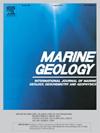Suspended particulate matter dynamics at the interface between an estuary and its adjacent coastal sea: Unravelling the impact of tides, waves and river discharge from 2015 to 2022 in situ high-frequency observations
Abstract
Suspended particulate matter (SPM) dynamics and exchange fluxes at the interface between a macrotidal estuary and its adjacent coastal sea were investigated from long-term high-frequency in situ observations. Optical and acoustic measurements were coupled to calculate SPM concentration over the whole water column using an existing acoustic inversion algorithm. A method was developed to distribute over the water column the surface and bottom calibrated equivalent particle diameters based on complementary ship-based surveys. Surface and bottom SPM show similar patterns in response to main forcings (tide, river discharge and waves), but present significantly higher concentrations near the bed. Increasing tidal ranges were responsible for higher tidal-median SPM concentrations, with spring/neap SPMC ratio varying from 2 to 3. This increase is driven by local resuspension during flood phase at the bottom, and low salinity turbid water flushed out from the estuary from mid-ebb to low tide at the surface. Increasing river discharge implies a downward shift of the estuarine turbidity maximum from the inner estuary to the mouth, and yields a 2-fold increase in both surface and bottom tidal-median concentration. Waves generated strong resuspension, with the highest SPM concentration recorded both at the surface and near the bed. Analysing SPM residual fluxes highlighted large up-estuary fluxes from low to moderate tidal ranges (below 6 m), and exporting seaward fluxes for higher tidal ranges, due to stronger mixing during spring tides. High river discharge enhanced stratification at the mouth and strengthened density circulation and up-estuary residual bottom circulation, resulting in larger up-estuary fluxes for all tidal ranges. Larger SPM concentrations along the tidal cycle during wave events yield high exporting fluxes.

 求助内容:
求助内容: 应助结果提醒方式:
应助结果提醒方式:


